| Article ID | Journal | Published Year | Pages | File Type |
|---|---|---|---|---|
| 10348729 | Simulation Modelling Practice and Theory | 2005 | 11 Pages |
Abstract
In a previous paper we generated animated agents and their behavior using a combination of XML and images. The behavior of agents was specified as a finite state machine (FSM) in XML. We used images to determine properties of the world that agents react to. While this approach is very flexible, it can be made much faster by using the power available in modern GPUs. In this paper we implement FSMs as fragment shaders using three kinds of images: world space images, agent space images and FSM table images. We show a simple example and compare performance of CPU and GPU implementations. Then we examine a more complex example involving more maps and two types of agents (predator-prey). Furthermore we explore how to render agents in 3D more efficiently by using a variation on pseudoinstancing.
Related Topics
Physical Sciences and Engineering
Computer Science
Computer Science (General)
Authors
Isaac RudomÃn, Erik Millán, BenjamÃn Hernández,
